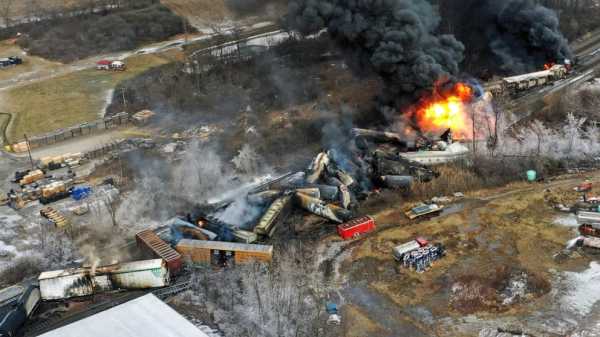
OMAHA, Neb. — The fire chiefs whose departments were the first on scene of February's fiery train derailment in eastern Ohio agree that firefighters need more training about hazardous chemicals, but that it would be hard for them ever to be fully prepared to deal with a disaster of this magnitude.
The National Transportation Safety Board is holding a two-day field hearing in East Palestine, Ohio, on the Feb. 3 Norfolk Southern derailment. Thursday's proceedings are focused on the emergency response to the derailment and the crucial decision officials made three days later to release the toxic vinyl chloride from five tank cars and burn it to keep them from exploding.
That move sent a towering plume of black smoke over the town near the Ohio-Pennsylvania border and prompted the evacuation of about half of East Palestine’s 5,000 residents. Officials have defended that decision as the best option when faced with the prospect of an explosion that would have sent shrapnel into the town.
But residents have many questions about possible lingering health effects even though state and federal officials say tests show the air and water in town remains safe.
East Palestine Fire Chief Keith Drabick said there was a consensus in the command center that releasing the chemicals from the cars and burning them was the “least bad option.” But Drabick and other first responders who testified at the hearing agreed that firefighters need more training — particularly volunteer firefighters who were first on the scene after the derailment — on how to handle hazardous materials.
“I don’t think you can ever be prepared for something like this,” Drabick said.
Ohio officials said volunteer firefighters receive only 36 hours of initial training when they are certified — significantly less than the 200 hours professional firefighters receive — and that no hazardous materials training is included.
The fire chiefs said the initial response to the derailment was complicated because the radios used by the different departments don't work with each other.
It also took some time for emergency responders to find out exactly what the train was carrying because the first firefighters on scene didn't have access to the AskRail app that railroads developed to provide that information. The train crew that had that information was a mile away after moving the locomotive and didn't immediately connect with first responders.
Drabick said it took about 45 minutes for his department to gather information about what was on the train.
The railroad has been digging up and removing contaminated soil and water from the derailment site. The Environmental Protection Agency and Ohio officials are overseeing the cleanup.
Norfolk Southern has committed more than $62 million to helping the town recover. The railroad has said it expects the derailment will eventually cost it nearly $400 million, although insurance will cover some of that and any other companies that are found responsible may have to contribute. The cost is expected to increase as lawsuits filed by states, the federal government and residents work their way through the courts.
The NTSB said in its preliminary report that an overheating bearing on one of the railcars likely caused the derailment, but it may take more than a year before the agency publishes its final report. The bearing started heating up miles before the derailment, according to sensors Norfolk Southern has along the tracks, but it didn’t get hot enough to trigger an alarm until just before the crash. The crew had little time to react.
Video gathered by investigators showed sparks or fire underneath one of the rail cars starting at least 26 miles before the derailment in Salem, Ohio.
The derailment, and several others since February, generated nationwide concern about railroad safety and prompted members of Congress to propose a package of reforms. Norfolk Southern’s CEO Alan Shaw was grilled at two different Senate hearings where he apologized for the derailment and promised to make things right in East Palestine.
All the Democrats on the House Committee on Oversight and Accountability sent Shaw a letter that was released Thursday morning expressing frustration that his railroad has refused to produce documents they asked for related to the way it uses trackside detectors and some of the operating decisions Norfolk Southern has made in recent years to slash its workforce and reduce costs.
The railroad has followed industry practice by running fewer but longer trains so it doesn’t need as many crews and locomotives. Rail unions have raised concerns that the cuts have made railroads riskier, while executives have defended their approach.
Norfolk Southern’s lawyers told the congressional committee that the railroad couldn’t release the internal documents because of the ongoing NTSB investigation. Committee Democrats have rejected that explanation and said the railroad knows that nothing about the NTSB probe should keep the committee from investigating. So far, the railroad has provided only two small batches of documents that appear to be publicly available.
“We are profoundly troubled by Norfolk Southern’s illegitimate efforts to mislead Committee Democrats and use NTSB’s investigation as a shield to impede Congressional oversight,” the 21 Democrats wrote in their letter.
Sourse: abcnews.go.com






